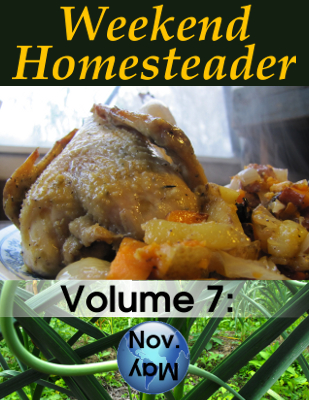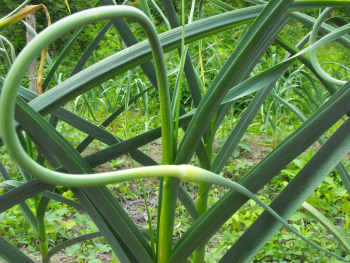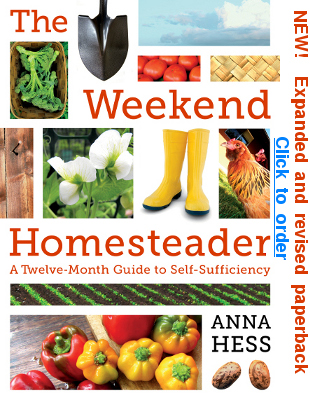
Methods of rotating
 Now that you've got your
map and spreadsheet in hand, you can plan out
next year's garden. For those of you who have been gardening in
the same spot for several seasons, the goal is to make sure that plants
in the same family don't
share the same soil for at least three years. That means that you
don't want your summer beans to follow your spring peas and don't even
want those beans to be in a bed that has grown peas, beans, or peanuts
for at least three years.
Now that you've got your
map and spreadsheet in hand, you can plan out
next year's garden. For those of you who have been gardening in
the same spot for several seasons, the goal is to make sure that plants
in the same family don't
share the same soil for at least three years. That means that you
don't want your summer beans to follow your spring peas and don't even
want those beans to be in a bed that has grown peas, beans, or peanuts
for at least three years.
Some gardeners keep
rotation extremely simple by dividing their garden into four sections
and growing different families in each
section. For example, if the northeast quarter of your garden is
home to the legume family, the southeast quarter to potatoes and
tomatoes, the southwest quarter to cucurbits, and the northwest quarter
to everything else, you can simple turn your map like a wheel to plan
next year's garden. Now your legumes go in the southeast
quadrant, the tomatoes in the southwest quadrant, and so forth.
Unfortunately, the
method outlined above has several problems.
Chances are your garden isn't entirely uniform, so the wheel rotation
method would often require you to grow vegetables in spots they don't
prefer from time to time. In my garden, a third of the
growing area has deep, loamy soil that's good for root crops and
another third is very sunny and perfect for spring and fall
crops. That means my brassicas are nearly always located in
the sunny third while carrots and potatoes dominate the loamy
third. The June
volume of Weekend Homesteader walks you through locating
each part of your vegetable
garden in the proper space.
Even if you are growing
on a completely flat area with no shade and with the
same soil type throughout, planting big blocks of the same type of
vegetable
together is asking for trouble. With the exception of corn
(which requires a large planting in one spot to allow for wind
pollination of the seeds), you'll have far less insect and disease
pressure if you scatter each type of vegetable throughout the
garden. Big blocks of similar plants mimic monoculture and often
lead to insect and disease epidemics. At the other extreme, a
diverse garden with beans beside tomatoes beside parsley will make it
tough for problematic insects to find the plants they prefer while also
tempting beneficial insects to spend time in every part of the garden.
 To add one more complication
to the mix, you should keep in mind that
you can often grow two or more different vegetables in the same bed
each year. For example, over-wintering garlic is harvested in
early
June, just in time to plant sweet potatoes. Spring leaf lettuce
takes
about a month to bulk up, can be cut for a month, and then turns
bitter, so I allot the lettuce two months out of the year. Your
notes
from last year will help you figure out how many months each crop will
take (and the May
volume of Weekend Homesteader explains when each one
should be planted), but there are always a few vegetables that are
pulled out early or don't come up. As a result, I generally plan
the
location for my vegetables in stages, first figuring out where each
variety will go for the spring planting (February to June) and only
later planning my summer and fall gardens.
To add one more complication
to the mix, you should keep in mind that
you can often grow two or more different vegetables in the same bed
each year. For example, over-wintering garlic is harvested in
early
June, just in time to plant sweet potatoes. Spring leaf lettuce
takes
about a month to bulk up, can be cut for a month, and then turns
bitter, so I allot the lettuce two months out of the year. Your
notes
from last year will help you figure out how many months each crop will
take (and the May
volume of Weekend Homesteader explains when each one
should be planted), but there are always a few vegetables that are
pulled out early or don't come up. As a result, I generally plan
the
location for my vegetables in stages, first figuring out where each
variety will go for the spring planting (February to June) and only
later planning my summer and fall gardens.
This
week's lunchtime series includes one of the four projects from Weekend
Homesteader: November.
Stay tuned for the rest of the series, or check out the 99 cent ebook
for more information on how to store drinking water for use during
power outages, to put an entire
chicken to use in the kitchen, and to bring in cash without going to
the office.
 This post is part of our Garden Rotation lunchtime series.
Read all of the entries: This post is part of our Garden Rotation lunchtime series.
Read all of the entries: |
Want more in-depth information? Browse through our books.
Or explore more posts by date or by subject.
About us: Anna Hess and Mark Hamilton spent over a decade living self-sufficiently in the mountains of Virginia before moving north to start over from scratch in the foothills of Ohio. They've experimented with permaculture, no-till gardening, trailersteading, home-based microbusinesses and much more, writing about their adventures in both blogs and books.
Want to be notified when new comments are posted on this page? Click on the RSS button after you add a comment to subscribe to the comment feed, or simply check the box beside "email replies to me" while writing your comment.
